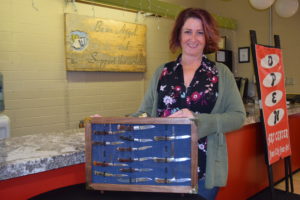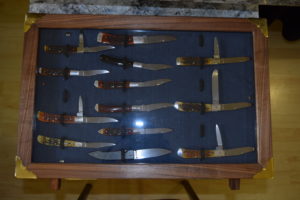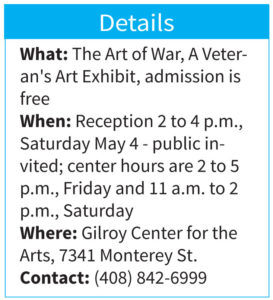Art of War, a veteran’s art exhibit, opens at Gilroy Center for the Arts
Exhibit spotlights a variety of artwork by Armed Forces service members
Click HERE for more stories published in the May 1 – 13, 2019 issue of Gilroy Life

Photo by Robert Airoldi
Rachel Perry displays her grandfathers knives that will be on display.
rt can bring healing and relief to those who have experienced trauma. It can also enable us to better understand someone else’s experiences. With that in mind, the Gilroy Center for the Arts opens a new exhibit, “The Art of War, A Veteran’s Art Exhibit” on April 27. Featuring the work of about a dozen veterans, the exhibit runs through May 25. There will also be a reception open to the public on Saturday, May 4, from 2 to 4 p.m.
“The people who inspired this exhibit were my father, Bob Clark, who fought in Vietnam, and both of my grandfathers,” said Rachel Perry, a GCA board member who is producing the exhibit. “My dad has always been tinkering. As a kid, I watched him make jewelry and later, knives. He doesn’t talk about his military service, but he’s involved with his local VFW (in Hollister). I figured he wasn’t the only veteran out there doing creative things to keep himself busy.”
And she was right. She reached out to local VFWs and American Legion posts, and several veterans answered the call.
Joe Kline, of Gilroy, is one of the artists whose work will be displayed in the exhibit. A Vietnam veteran, Kline creates aviation art.
 “I always had a talent for drawing,” he said. “I spent two years in college, then went into the Army. When I came home from Vietnam, I started painting. I was interested in aviation art because of my father,” who was a B-25 bombardier with the 340th Bomb Group in the Mediterranean Theater during World War II. Kline served as a Huey helicopter crew chief with the U.S. Army’s 101st Airborne Division during the Vietnam War.
“I always had a talent for drawing,” he said. “I spent two years in college, then went into the Army. When I came home from Vietnam, I started painting. I was interested in aviation art because of my father,” who was a B-25 bombardier with the 340th Bomb Group in the Mediterranean Theater during World War II. Kline served as a Huey helicopter crew chief with the U.S. Army’s 101st Airborne Division during the Vietnam War.
But besides the family connection, Kline recognized how deeply personal his military art can be. Originally, he began doing one-off pieces for veterans, usually commissioned by a family member. Then he realized he could do limited edition prints and customize them.
“People don’t always have an appreciation for how attached a veteran becomes to their aircraft,” he said. “Some might have old, grainy black and white photos, but some have nothing. It’s really touching to these guys, their family members, and me, to see how these prints affect them.”
 Kline personalizes his work with the nose art, tail number, and squadron paint, and other distinctive markings, so that recipients can preserve their memories.
Kline personalizes his work with the nose art, tail number, and squadron paint, and other distinctive markings, so that recipients can preserve their memories.
“It’s put me in touch, in the last 25 plus years, with literally thousands of Vietnam veterans, mostly air crew,” he said. “It’s been a very rewarding experience. Then after Iraq and Afghanistan, I started getting requests from those guys. There are better artists than me. But what gives me ‘street cred’ is that I lived that stuff.”
Kline shared that when he was growing up, some of his art teachers were encouraging, but some were not. One commented that his realistic style wouldn’t be well-received.
“She said, ‘If you want something that looked like that, why wouldn’t you just take a photo?’ Well, years later, and I can remember distinctly, I’d gone out jogging and was thinking about Riders on the Storm,” which is a piece that depicts UH-1 Hueys inserting troops into a ‘hot LZ’ (enemy landing zone) during the Vietnam War.
“I was thinking about how I wanted to paint it,” Kline continued. “I came home and looked in books and couldn’t find a picture of the Huey. I realized that’s because the picture was in my head. Sometimes, you’re too busy to be taking photos. So, yeah, ‘why wouldn’t you just take a picture?’ I got the last laugh on that, lady.”
For many vets, creating art is an opportunity to channel their trauma into productive energy. It’s common for those returning to struggle to come to grips with post-war life as they rejoin the civilian sector. So many veterans fall into destructive behaviors. In fact, it’s estimated that 22 American veterans take their lives each day. And many believe that number is significantly higher. Creating art could provide an effective form of therapy for those who are at risk and processing strong, and often painful, emotions.
“My maternal grandfather is a World War II veteran,” Perry said. “He was always doing something, like woodworking. As I’ve gotten more involved in the art community in Gilroy, I’ve met more veterans who always keep themselves busy, whether they’re building something, painting, making lithographs, or something else.”
Perry estimates there will be 20 to 30 pieces in the exhibit, each one as unique as the vet who took time to create it. In addition to her father’s knives, the exhibit will include paintings, jewelry, metal work, wooden pieces, lithographs, and more. She also plans to include information on artists who have served in the military, as well as uniforms and other displays.
“I have my maternal grandfather’s naval jumper, which is made of wool,” Perry said. “And my dad’s flak jacket and medals. I’ll also have lots of medals, patches, and other items from my paternal grandfather, who served in both the Army and the Navy.”
But the impact of this event extends beyond the gallery walls. It’s intended to spread out and affect the veteran community in multiple ways.
The exhibit is sponsored by Operation Freedom Paws, which empowers veterans, as well as individuals with disabilities, by teaching them how to train their own service dogs, creating a human-canine team. OFP will be at the reception to give demonstrations with some of their dogs and to talk about their nationally-recognized program.
DreamPower Horsemanship will also be at the reception, to highlight their Horses for Warriors program. DreamPower, located in Gilroy, offers equine-assisted activities such as psychotherapy, learning, and therapeutic horsemanship. They’ll be on hand to give a brief overview of their program, and some of its participants will be there to answer questions.
“I wanted to give local veterans an opportunity to share what they do,” Perry said. “They will have an opportunity to speak at the reception if they want. They may talk about the process. But I want people to feel comfortable with what they want to share. This is a safe place.”
